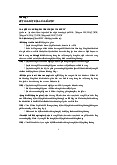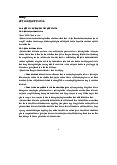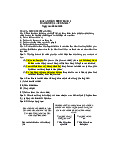





Preview text:
IFRS 15 Exercise 1
An entity enters into a contract with a customer to build a
customised asset. The promise to xtransfer the asset is a
performance obligation that is satisfied over time. The promised
consideration is $2.5 million, but that amount will be reduced or
increased depending on the timing of completion of the asset.
Specifically, for each day after 31 March 20X7 that the asset is
incomplete, the promised consideration is reduced by $10,000. For
each day before 31 March 20X7 that the asset is complete, the
promised consideration increases by $10,000.
In addition, upon completion of the asset, a third party will inspect
the asset and assign a rating based on metrics that are defined in
the contract. If the asset receives a specified rating, the entity will be
entitled to an incentive bonus of $150,000. Required: (a)
Calculate the transaction price if entity estimates 60% chances
that there will be delay of two days (40% chance that it will build on
due date) and 70% chances that specified rating shall be received. (b)
Calculate the transaction price if entity estimates 35% chances
to build 5 days before due date, 40% chances to build on due date
and 25% chances that delay of two days will be made. There is 45%
chance that specified rating shall be received. Exercise 2
Company A sells a cable TV system to customer B under the
following terms on 1 October 20X2:
Customer has to pay a monthly fee of $80 for 12 months and get a
free cable TV set top box and access to all the TV channels at the contract signing date
Company A sells the set top box by itself for $250 and charges
monthly access to the TV service without the set top box for $65 a month
What amount of revenue should company recognise in the year ended 31 December 20X2? Exercise 3:
Pluto Limited (PL) sells industrial chemicals at the following standalone prices: Products $ (per carton) C-1 100,000 C-2 90,000 C-3 110,000
PL regularly sells a carton each of C-2 and C-3 together for $ 170,000. Required:
Calculate the selling price to be allocated to each product, in case PL
offers to sell one carton of each product for a total price of $260,000. Exercise 4:
The following details apply a contract where performance obligations
are satisfied over time at 31 December 20X5 Total contract revenue 120,000 Costs to date 48,000 Estimated costs to completion 48,000 Amounts invoiced 50,400
The contract is agreed to be 45% complete at 31 December 20X5 as a contract asset? Exercise 5:
ABC entered into a contract with Thomas to provide a custom-made
bed frame. The contract price is $3,000 and it includes delivery and
installation. ABC does not provide installation services separately The standalone market prices: - Installation is $200 - Delivery is $200
- Similar custom-made bed frame is $2,800 Exercise 6:
The F/S for year ended 30 September 20x4, of Chamberlain shows a
2 years construction contract with a cost to date $35m, progress
billing received $30m commenced on 1 October 2003. Total agreed
contract price is $125m, expected contract cost $75m. The
percentage of completion is determined by the contract costs to date
over the total contract costs. Of the $35m cost to date, $5m related
to materials delivered to site but has not been used. Determine the
amount of contract asset/liability?
MULTIPLE CHOICE QUESTION
1. Which of the following is false?
a. The objective of IFRS 15 is to establish the principles that an entity
shall apply to report useful information to users of financial
statements about the nature, amount, timing and uncertainty of
revenue and cash flows arising from a contract with a customer.
b. The core principle of IFRS 15 is that an entity shall recognize
revenue to depict the transfer of promised goods or services to
customers in an amount that reflects the consideration to which the
entity expects to be entitled in exchange for those goods or services.
c. When accounting for a portfolio contracts using IFRS 15, an entity
shall not use estimates and assumptions that reflect the size and composition of the portfolio.
d. An entity shall not apply IFRS 15 to contracts involving non-
monetary exchanges between entities in the same line of business to
facilitate sales to customers or potential customers.
2. It is a party that has contracted with an entity to obtain
goods or services that are an output of the entity’s ordinary
activities in exchange for consideration. a. Seller b. Potential buyer c. Customer d. Contractee
3. Which of the following is not a criterion for a contract to
be accounted for using IFRS 15?
a. The entity can identify each party’s rights regarding the goods or services to be transferred.
b. The entity can identify the payment terms for the goods or services to be transferred.
c. The parties to the contract must be approved the contract in
writing and are committed to perform their respective obligations.
d. The contract has commercial substance
4. Which of the following is most related to trade discounts and rebates? a. Receivable discounting b. Price increase c. Price concession d. Sale and buy-back
5. Which of the following is incorrect regarding contract modification?
a. A contract modification is a change in the scope of a contract that
is approved by the parties to the contract without changing its price.
b. A contract modification may be described as a change order, a variation or an amendment.
c. A contract modification exists when the parties to a contract
approve a modification that either creates new or changes existing
enforceable rights and obligations of the parties to the contract.
d. If the parties to the contract have not approved a contract
modification, an entity shall continue to apply IFRS 15 to the existing
contract until the contract modification is approved
6. The price at which an entity would sell a promised good or
service separately to a customer. a. Transaction price b. Stand-alone price c. Contract price d. Performance price
7. Which of the following is not a criterion if an entity is to
account for a contract with a customer in accordance with IFRS 15?
a. The parties to the contract have approved the contract (in writing,
orally or in accordance with other customary business practices).
b. The entity can identify the payment terms for the goods or services to be transferred.
c. The contract has commercial substance.
d. it is virtually certain that the entity will collect the consideration to
which it will be entitled in exchange for the goods or services that
will be transferred to the customer.
8. It can be described as a change order, a variation or an amendment. a. Contract modification b. Contract asset
c. Change in accounting estimate d. Combination of contract 9.
Statement I: An entity shall recognize as an asset the incremental
costs of obtaining a contract with a customer if the entity expects to recover those costs.
Statement II: The incremental costs of obtaining a contract are those
costs that an entity incurs to obtain a contract with a customer that
it would not have incurred if the contract had not been obtained. a. True; True b. True; False c. False; True d. False; False
10. Enforceability of the rights and obligations in a contract
with a customer should be governed by the a. IFRS 15 b. Law governing the contract c. Conceptual framework
d. Entity's management decision



